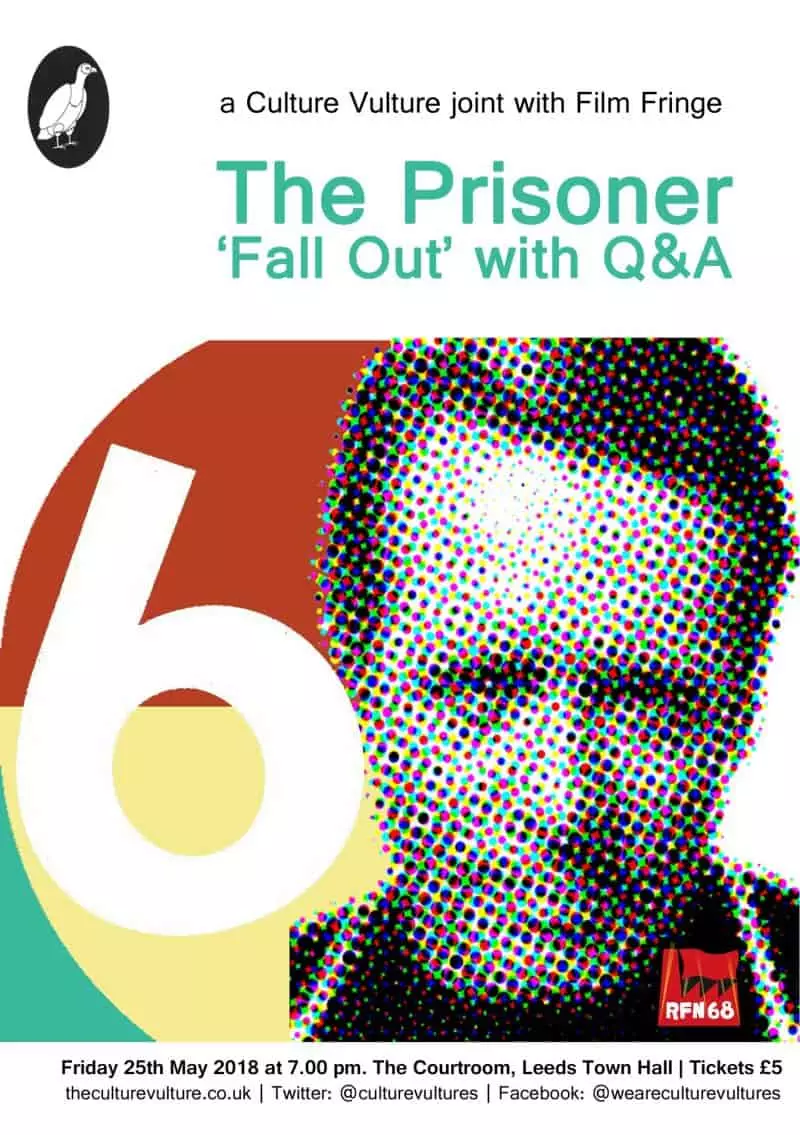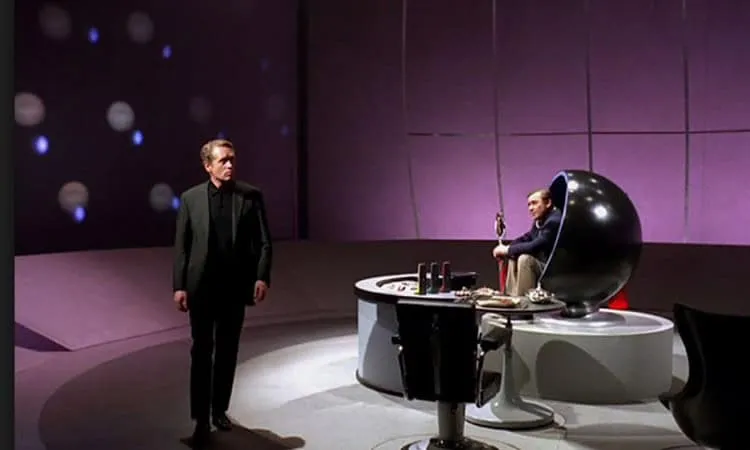Photo: Number 6 (Patrick McGoohan) meets Number 2 (Guy Doleman) in Arrival…
To count down to our special screening of Fall Out, the final episode of ace television show The Prisoner, PHIL KIRBY introduces a new episode every day in the order outlined by director Alex Cox in his book I Am (Not) A Number…
Tonight’s episode is Arrival …
After handing in his resignation, an ex-spy is drugged and kidnapped, waking to find himself prisoner in a secret detention facility known as The Village. Unable to get a straight answer from any of the colourfully-clad residents he meets (all of whom wear a badge with a number), the prisoner encounters Number 2 who appears to be in charge. Number 2 questions him about his resignation and where his loyalty lies. Assigned the number 6, the prisoner plots an escape with the help of Cobb, a former agent and another inmate, number 9. But when Cobb apparently commits suicide, is everything what it seems, and who can Number 6 actually trust?
In his book, I Am (Not) A Number, film-maker Alex Cox makes a persuasive case that The Prisoner makes more sense if viewed in the order each episode was made. Thus the series would look like this: Arrival ; Free For All ; Checkmate ; Dance of the Dead ; Chimes of Big Ben ; Once Upon a Time ; Schizoid Man ; It’s Your Funeral ; A Change of Mind ; The General ; A. B. and C. ; Hammer Into Anvil ; Many Happy Returns ; Do Not Forsake Me Oh My Darling ; Living in Harmony ; The Girl Who Was Death ; Fall Out
The first episode, Arrival, sets the scene. Where Number Six has come from, where “they” have taken him to, and what “they” want.
Most interpretations assume Number Six is a former spy. I agree with Alex Cox this is unlikely.
Watch the opening title sequence.
What sort of spy would personally deliver a handwritten resignation, give the boss a right ticking off, allow himself to be obviously tailed home (by an undertaker), faff about for ages packing his socks, and allow himself to be the victim of knock out gas in his own home?
He’s no James Bond.
Also, in the hospital scene where he meets an ex-colleague, he seems to be taken in by Cobb’s apparent death. Had Number Six been a spy he would have been fully briefed by the CIA’s Assassination Manual, which states that a “fall” from a window would need to be from at least 75 feet, onto hard ground, to ensure the desired outcome. The hospital in the Village is only a couple of storeys high and surrounded by grass as far as it’s possible to tell. Cobb may have sustained a concussion, a fracture, and maybe a broken bone, but it’s not likely he would have died even if he’d been thrown from the window (he had barely the energy to speak let alone dash halfway across a hospital ward.)
Alex Cox mentions the story of Frank Olson in regard to this incident. Olson was involved in manufacturing nerve gas, a bit like the stuff that takes out Number Six in the title sequence.
Olson was also involved in Camp King in Germany, which may have been “information” that made him “priceless on the open market.” And prompted him to consider resignation.
Most of The Prisoner fan sites name Inverlair in Scotland as the inspiration for the Village, as does Alex Cox. I think Camp King is a closer match. Located in an isolated and idyllic setting and architecturally crackpot, funded by the CIA, run by Ivy League scientists, employing ex-Nazis as part of the team, and interrogating unwitting human subjects with a variety of methods – including the use of the recently discovered LSD – Camp King is perfect. Oh, and the guy who ran it published the most widely cited post-war paper on medical ethics in the New England Journal of Medicine in 1966… “Which side are you on?” seems a reasonable question.
In an autobiography by James Angleton, the chief CIA officer in charge of America’s counter-intelligence when The Prisoner was filmed, the politics of the period is called a “wilderness of mirrors.”
The phrase perfectly captured the “myriad of stratagems, deceptions, artifices, and all the other devices of disinformation which the Soviet bloc and its coordinated intelligence services use to confuse and split the West … an ever fluid landscape where fact and illusion merge.”
On the surface The Village as mirrored in The Prisoner has got everything you could possibly want; a sense of community, diversity, greenery, great social housing, health care, a civic leadership who tirelessly encourage the arts… even a lighthouse. Everyone is valued. Nobody need be lonely. They just want your involvement. The price is participation. And it’s a strategy that seems to be working for most of the Villagers.
The place would have been in the running for European Village of Culture 2023.
The problem for Number Six is how he breaks out of the mirror.
“They” want “information.” But all that can appear in a mirror is behaviour. Even if Number Six behaves himself and goes along with the pretence of willing participation, even if he gives them the answer to why he resigned (which he does, at least three times) it will never be enough. His answer could be strategem, deception, artifice and disinformation. “They” can never see “you”, just a reflection. Or a projection.
The other question is, why would anyone give up precious information to a “they” who never reveal which side they are on?
Each subsequent episode examines the limits “they” will go to make Number Six comply in answering a question both know cannot be adequately answered.
“He’s a tough nut to crack,” is the final evaluation on Number Six as Cobb is revealed in the end to be working for “new masters.” Which is fine, considering we haven’t a clue who the old masters were.
Each episode in the series gets progressively crackers.
And if Number Two is nuts in the first episode, he’s a complete fruitcake by the end. As we shall see.
Be seeing you.
theCV presents The Prisoner Fall Out plus a Q and A with Six of One’s Ant Brierly and Roy Stambrow moderated by Phil and Neil (God help us!) at The Courtroom, Leeds Town Hall at 19.00 on Friday 25th May 2018. Tickets are £5 (plus booking fee) and are available here.

